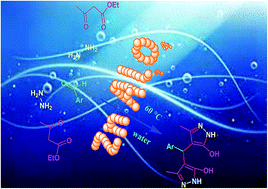Pseudo five-component process for the synthesis of 4,4′-(arylmethylene)bis(3-methyl-1H-pyrazol-5-ol) derivatives using ZnAl2O4 nanoparticles in aqueous media
Abstract
In the present paper, we report the successful synthesis of zinc aluminate nanoparticles by the co-precipitation method using aqueous ammonia solution as the precipitating agent. ZnAl2O4 nanoparticles have been used as an efficient catalyst for the preparation of 4,4′-(arylmethylene)bis(3-methyl-1H-pyrazol-5-ol) derivatives by pseudo five-component reaction of hydrazine hydrate, ethyl acetoacetate and aldehydes at 60 °C in water. Atom economy, wide range of products, excellent yields in short time and environmental benignity are some of the important features of this protocol.


 Please wait while we load your content...
Please wait while we load your content...